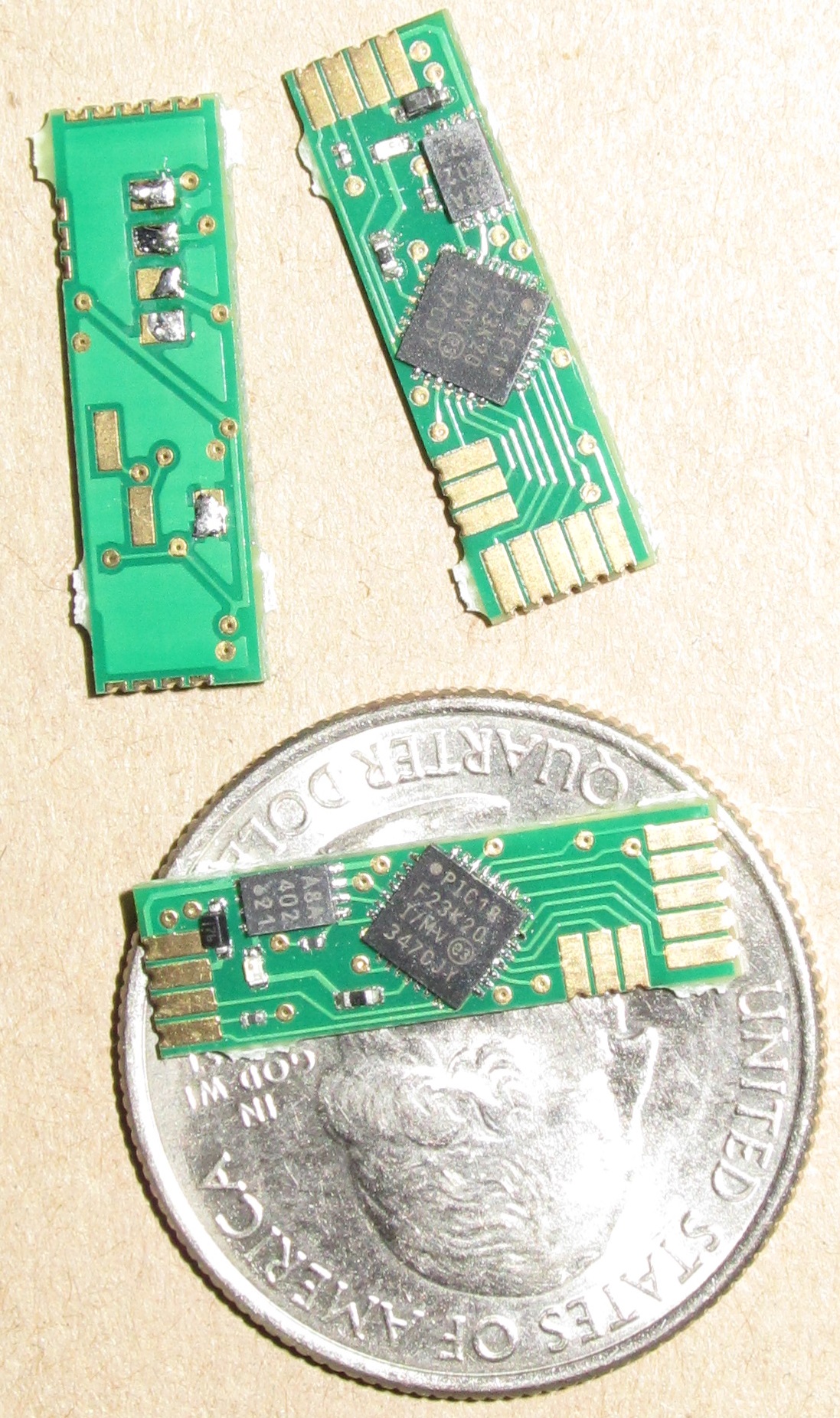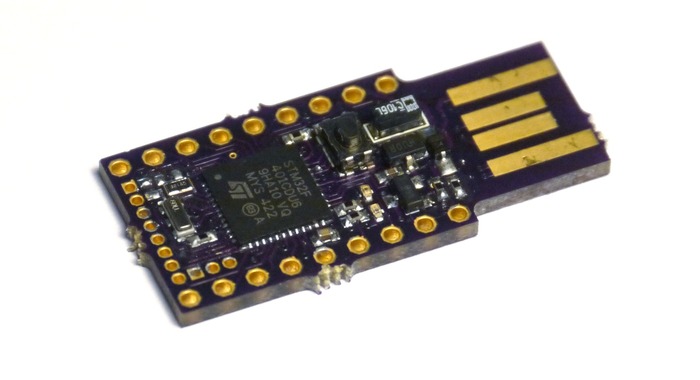-
• #52
You don't want the USB connector...? Why not just not use it?
There are also hidden pads (on the back of the USB connector) for a USB mini (or was it micro?) connector, if you scratch through the soldermask. That might provide a good way to connect to it...
In any event, the project is open source, so you can always take the Eagle files, modify it to your tastes, and then have boards fabbed by OSH, and then load the boards yourself. I may do that when the design is finalized, though probably without loading anything other than the pin headers (just to judge fit of potential addons - I want to have an SD card adapter ready to drop on that 0.05" pin header when my picos come :-P). If I wanted to load everything, I'd have to modify it to use bigger passives. Even with my reflow oven kit (ControLeo2 toaster oven conversion kit) coming this weekend, I don't like the thought of working with those tiny resistors.
-
• #53
I can definitely use the xPico as is for prototyping. I love the idea of the USB design.
I was thinking in more of the lines of esthetics for the 'final version' of my project.
I've always wanted a reflow oven kit, but I have no idea where to start for an inexpensive hobby reflow oven.
-
• #54
There's actually Micro and Mini USB now. I thought if I was going to have to cover up the pads then I might as well put on everything I could.
An SMD-able board had been suggested - but it's a long way off I'm afraid. Long term I'd like to make one SMD board that I could produce in volume and then fit to any other board that I sell. But as @DrAzzy says, it should be trivial to take the designs when they're released, and then to remove the pins and put something else on.
Having said that, the Pico should be pretty good for small scale commercial use. That was the idea. I'll try and produce an eagle library for it, so it should be trivial to make a board that it will connect to.
Personally I think that for small-scale manufacture, through-hole is probably still the way to go. If you've got a reflow oven, solder mask, and a good PCB then you might as well just make your own PCB with an STM32 on it.
-
• #55
@d0773d what if the Espruino Pico board had castellations around the edge in addition to pins?
I'm not convinced it'd be a good idea to have them for USB because of the risk of shorts, but nothing stops you from cutting away the edge of the PCB you connect it to so you can still get a USB connector onto it - or even just blobbing up the solder if its for personal use.
-
• #56
@Gordon that was exactly what I thought! I didn't know what the terminology was called. Having both pins and castellations seems like a really good idea; however, I don't have experience with that design. Soldering the constellation design doesn't seem to difficult though, but I wouldn't feel comfortable hacking away at the PCBs to create an espruino with constellations.
I also thought about leaving the USB design for the board allowing me to solder the board down on the main board while leaving the USB side sticking off the side of the main board. Then use an USB cable specifically designed for an enclosure, where both sides of the cable are female, one side of the cable hooks onto the Espruino USB while the other female side of the USB cable attaches to inside of the encloser. I know that type of cable exists, I just forgot what the cable is called.
-
• #57
Yes, that'd be preferable - but you can also add Micro or Mini USB now, as long as you're willing to scrape off some solder resist.
I've asked how much extra the castellations will cost. Hopefully not much, but they're actually done by creating holes and cutting through them, so I guess it blunts the milling machine more quickly.
-
• #60
It's good thanks. I'm taking a break for the next few days, but the parts that had a longer lead time are now ordered, and there's now hopefully a final board design, with fabricated PCBs waiting for me at home for when I get back.
So when I'm back I'll build up some boards and test them out, and once I'm happy with them I'll get the rest of the stuff ordered - and manufacturing could start around 3 weeks after that.
And yes, the castellations added 10p, so I'm going to go for it unless the board manufacturer absolutely can't handle it (they didn't like the fact that they go around 3 sides of the board, but I think we can workaround that).
-
• #61
I don't know much about board manufacturing, but I just got these in the mail. They were wrapped in thin foil and I almost tossed them because I couldn't believe there was anything in there. When I put on my glasses, I noticed they had castellations. Just thought I would share because they were so tiny.
Dimensions are 0.24 x 0.79 x 0.07 inches or 6.1 x 20.1 x 1.8 mm.
1 Attachment
-
• #62
Thanks - that is pretty small! Are those 0.1" pads, or 0.05"?
If you imagine those long gold pads, but a bit shorter and with a hole in the middle then that is what the Pico's will look like. It'll mean you can easily solder 0.1" pins to it, or you can place it on a PCB.
-
• #63
If a pad is measured by width from the edge of one pad over to the edge of the next pad, then it is 0.05". I guess it would have been simpler to say 'center to center' huh? The guy selling those chips claims you can solder those pads without glasses...he must have better eyes and steadier hands than I.
-
• #64
I think there's a problem with the new Pico layout - it involves the 0.05" pins....
In the pictures, I see the two rows of 0.05" at right angles to eachother - this will be made up of 2 pieces of pin header. Looking at my 0.05" pin header, the black plastic is 0.0940" wide, while there is a 0.035" gap between each pin. That means the black plastic is completely covering the place where the closest pin in the other row needs to be. This seems to be a problem with all the 0.05" pin headers I have - the male TH has width of 0.94", female TH 0.71", male SMT 0.825" In order to be able to place the headers like that, they'd need to be no greater than the pitch of the pins in width - which isn't the case.
-
• #65
Here is the latest picture on KickStarter for anyone interested...
1 Attachment
-
• #66
@DrAzzy, nice observation... to solve the problem, the longitudinal set of 3 .05" pins would have to move 0.05" in USB direction to be able to solder in your headers, and have the space for the connecting cable headers. Is that correct?
Moving the 3 new pin holes may create some challenges for the routing by looking at kickstarter update 11 and guessing to what or which processor pins they are connected to.
2nd makes me think about the distance between the .05" and the .10" pin rows. What is your verdict there?
-
• #68
I'm too green, I can't even envision how the pico will be used with castellations around 3 sides plus 3 interior pin holes.
-
• #69
@allObjects, believe it is 16KB EEPROM, Microchips 24FC128.
http://www.microchip.com/wwwproducts/Devices.aspx?dDocName=en010800
http://www.mouser.com/Search/Refine.aspx?Keyword=24FC128My chrome seems to be broken, pressing the link button does nothing for me :(
-
• #70
@DrAzzy, it's a bit difficult to find single row, 1.27mm/0.05" spaced headers. Finally found this catalog pagae from Samtec. Stackables I found at http://www.gct.co - http://gct.co/pcb-board-to-board/1-27mm-pin-header-socket.aspx?NumberOfRows=Single&Pitch=1.27mm&
...
-
• #71
http://cloud.samtec.com/catalog_english/CLP_SM.PDF
Bottom left of page, it says contact Samtec for single row.
-
• #72
Looks like double row 1.27mm/0.05" spaced headers are easier to come by... but that would defeat/contradict castellations (as the 3 inside holes on the board already do...).
-
• #73
another source...
Male: http://www.harwin.com/product-search/M52-Variants/
Female: http://www.harwin.com/product-search/M52-500/ -
• #75
I think it's Vbat, 3.3 and ground?
 DrAzzy
DrAzzy d0773d
d0773d Gordon
Gordon Manxome
Manxome

 allObjects
allObjects
Is there plan to create another espruino Pico board offering all SMD and without the USB?
My thinking is to create a separate board to solder the xPico board down to.
The separate board will also have a USB port, power jack and other pinouts. The pinouts will be used for connecting a display and etc. The purpose of this idea is to create a more commercial/permanent/stationary project that will be mounted inside of a project box that also has a display.
This idea probably isn't popular enough to sell, but what about a section on GIT hub that lists espruino board variations?